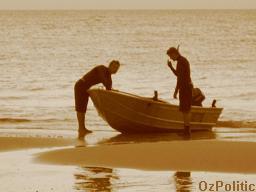Destructive Fishing Practices
Previous
Next
Up
Home
Check out our hunting and fishing discussion board.
 Summary:
Summary:
Australia is committed to phasing out destructive fishing practices by 2012. However, neither the Australian Fisheries Management Authority (AFMA) nor the fisheries management agencies of the States have developed policy statements on destructive fishing practices which could chart a course towards the 2012 goal. A wide definition of destructive fishing practices would include overfishing beyond reasonable recovery, damaging levels of bycatch, fishing of spawning aggregations, bottom trawling over vulnerable habitat, and ghost fishing by discarded gear. In one form or another all these activities currently occur within the Australian Fishing Zone.
Background:
The Outcomes Statement of the World Summit on Sustainable Development, held in Johannesburg in 2002, contains a commitment to phasing out destructive fishing practices in the marine environment by the year 2012. Australia supported this statement, as did all other nations attending the Summit.
Many nations had made commitments to end destructive fishing practices much earlier. In 1999, 124 nations explicitly gave their support to the FAO Code of Conduct for Responsible Fisheries 1995 through the Rome Declaration on Responsible Fisheries. The list of these nations includes Australia. However, while the Code of Conduct contains a commitment to end destructive fishing practices, the Code (naturally enough) contains no time-lines.
The narrowest definition of destructive fishing practices might refer principally to bottom trawling over vulnerable habitat (deep sea corals, for example), practices such as shark-finning, along with blast-fishing and poison-fishing. These latter practices are thankfully not significant within the Australian fishing zone.
A wider and more useful definition would include:
- overfishing beyond reasonable recovery limits;
- damaging levels of bycatch;
- the fishing of spawning aggregations; and
- bottom trawling over vulnerable habitat.
This definition could be extended to cover activities such as:
- ghost fishing by lost or discarded gear,
- shark netting of popular swimming beaches (with high incidental catch),
- amateur use of fish aggregating devices where they increase the likelihood of unsustainable catch levels affecting local ecosystems,
- spearfishing at night or with SCUBA,
- use of stainless steel hooks; and
- deliberate (and sometimes illegal) destruction of marine life perceived as “getting in the way” of fishing operations.
All these activities, in one form or another, continue in the Australian Fishing Zone under the regulation of either AFMA or State fisheries management agencies, or both. A notable example of destructive deep sea trawling associated with unsustainable bycatch is the orange roughy fishery over the Cascade Plateau in south-eastern Australia.
However, Australia has taken a lead in addressing particular DFPs, such as albatross bycatch, for example (through the CSIRO). The FRDC has also taken an interest in scientific research on some DFPs.
Policy change within fisheries agencies:
Fisheries management agencies around the world have a history of moving slowly, often very slowly, to accommodate changes in both science and community attitudes (Hilborn 1992, Ludwig et al. 1993, Cochrane 2000).
An internet search carried out on 5 October 2006 indicated that no Australian fisheries management agency has undertaken preparation of a broad-ranging policy on destructive fishing practices. Moreover, the search revealed that, of 16 regional fisheries management organisations (RFMOs) only one (CCAMLR) has commenced development of such a policy, and this document is still in draft form. The global search similarly failed to find evidence of the development of a wide-ranging policy by either management agencies, fisher organisations, or marine conservation organisations – in spite of the importance of the issue world-wide.
A copy of this paper including endnotes and references may be obtained from jon_nevill@yahoo.com.au, or Jon Nevill PO Box 106 Hampton 3188 Australia.

| 

